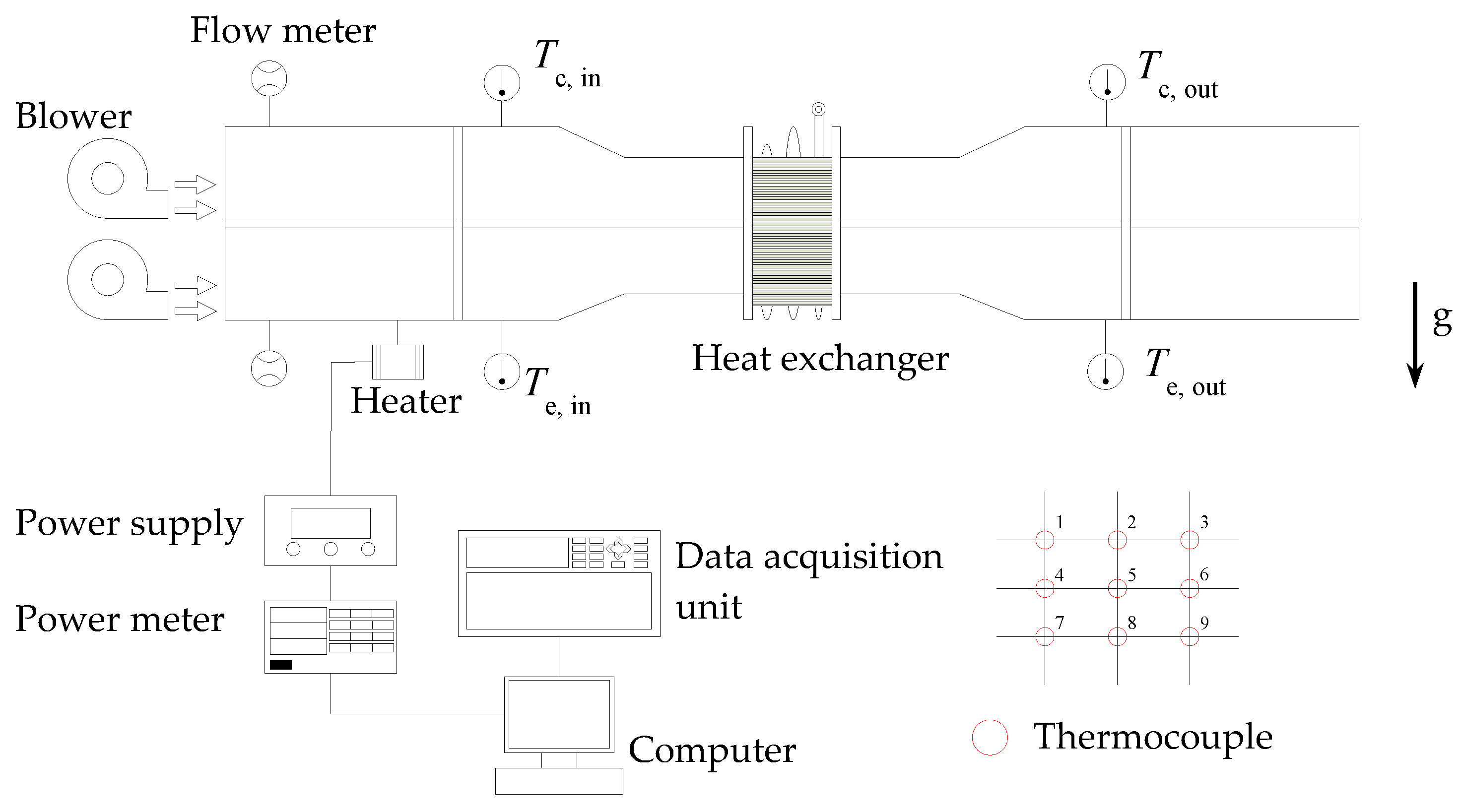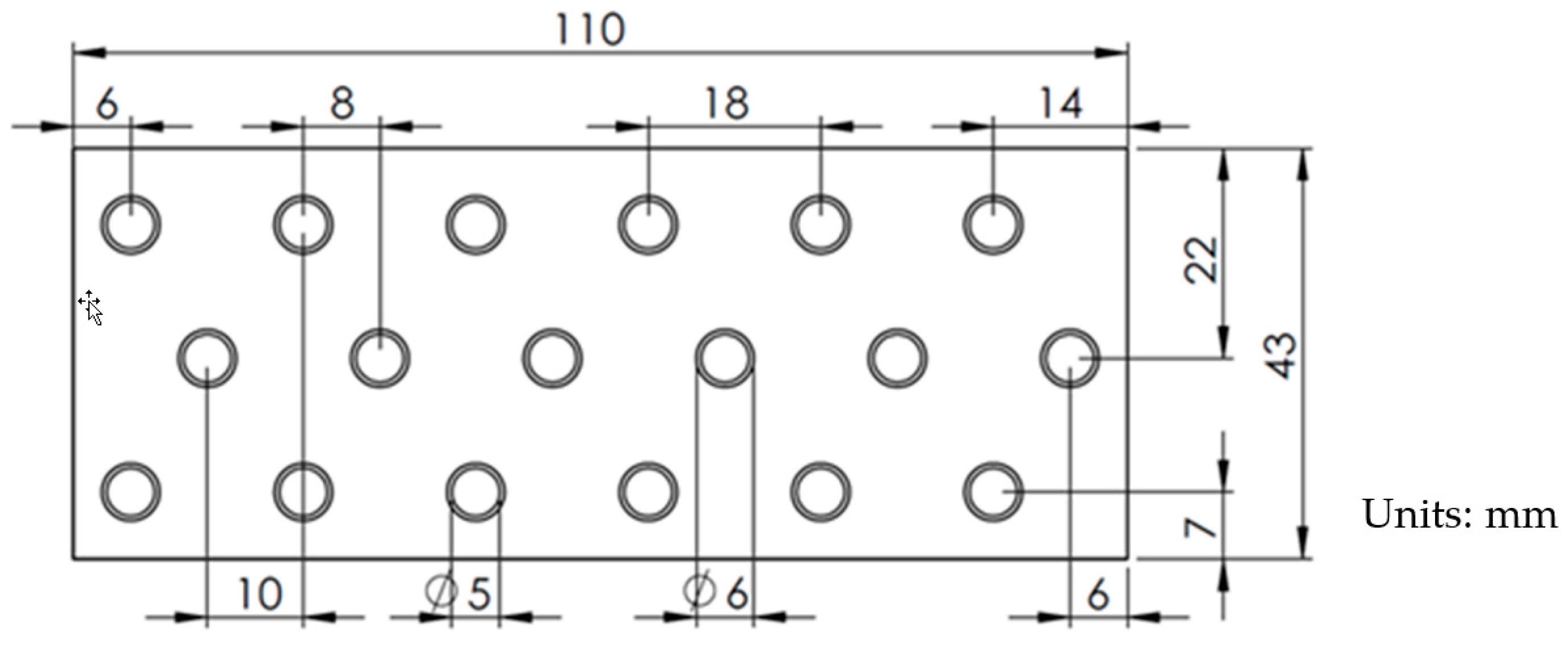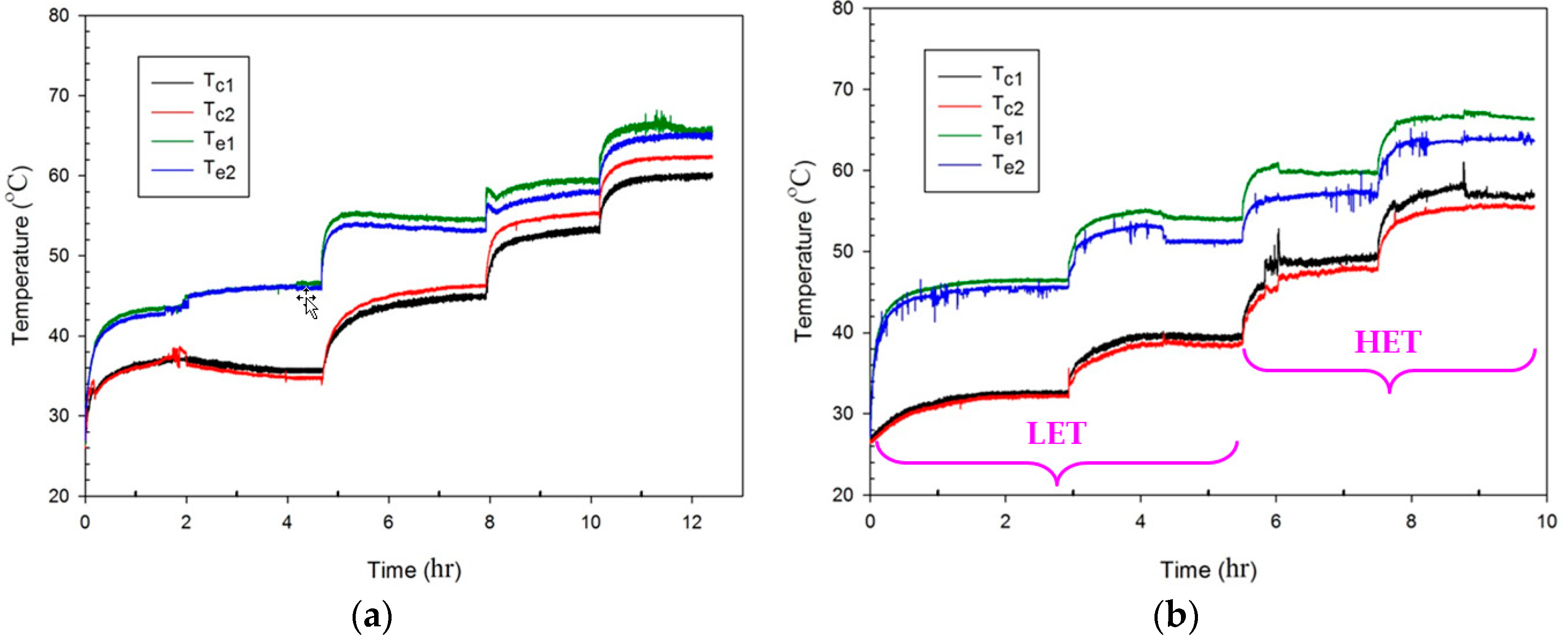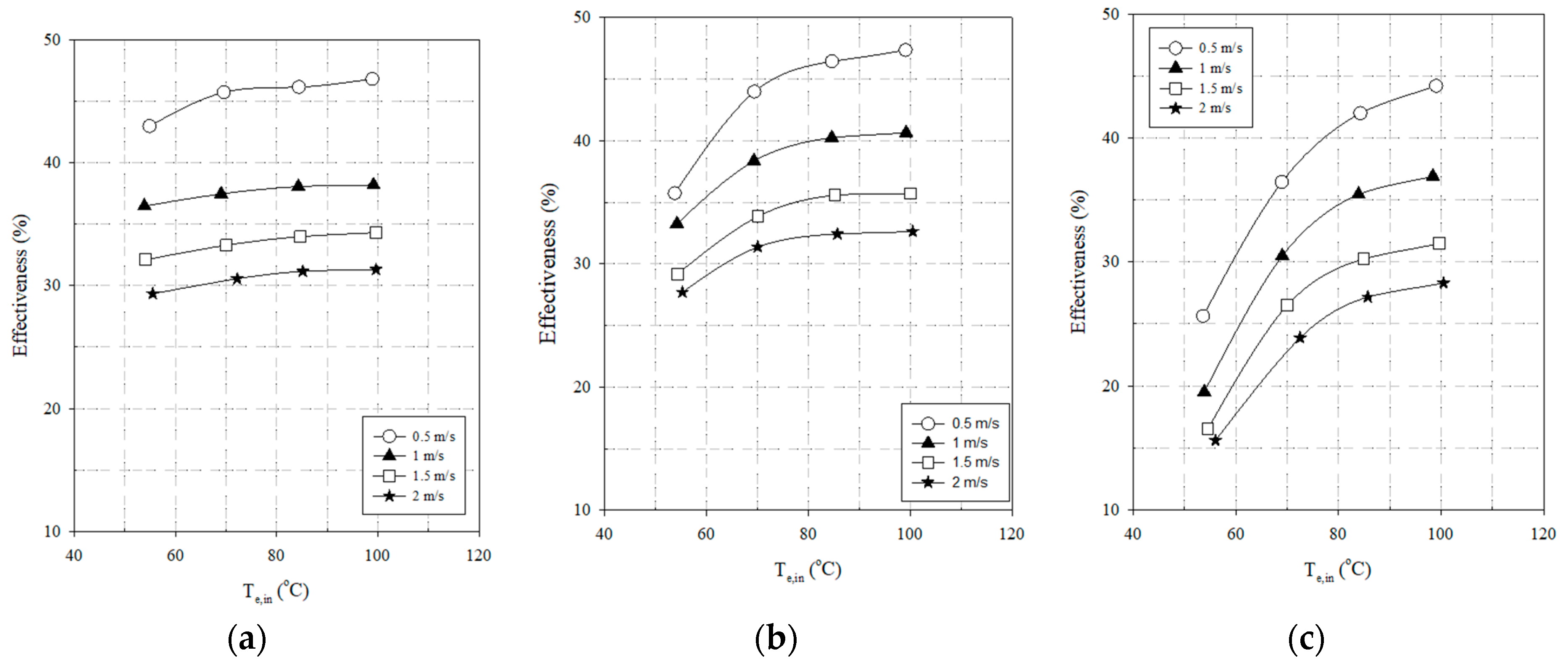Experimental Investigation on the Thermal Performance of Pulsating Heat Pipe Heat Exchangers
Abstract
:1. Introduction
2. Experiment
2.1. Exprimental Setup
2.2. Data Reduction
3. Results and Discussion
3.1. Uncertainty
3.2. Thermal Performance of the Heat Exchanger
4. Conclusions
- The heat pipe charged with HFE-7000 in each filling ratio is likely to function as an interconnected array of thermosiphon under all tested conditions because the tube inner diameter is too large to cause the start-up of pulsating movement of the vapor and liquid slugs, whereas the water-charged PHP possibly acts as a PHP once the evaporator temperature is high enough, especially in a filling ratio of 50%.
- The difference in effectiveness of the PHP heat exchangers charged with HFE-7000 with and without degassing became less as the evaporator temperature was increased, because the negative impact on the thermal performance of the HFE-7000-charged heat pipe become diminished.
- Water is a better working fluid than HFE-7000 in this study while employing the PHP heat exchanger at an evaporator temperature higher than 70 °C. On the other hand, HFE-7000 is a better working fluid while employing the PHP heat exchanger at an evaporator temperature lower than 70 °C.
- The effectiveness of the HFE-7000-charged PHP heat exchanger in a filling ratio of 35% reached 43% at an evaporator temperature of 55 °C at an airflow velocity of 0.5 m/s, while that of the water-charged one in a filling ratio of 35% was approximately 47% at an evaporator temperature of 100 °C at an airflow velocity of 0.5 m/s.
Author Contributions
Funding
Acknowledgments
Conflicts of Interest
Nomenclature
| A | heat transfer surface area (m2) |
| C | heat capacity rate (J/°C·s) |
| Cmin | minimum heat capacity rate (J/°C·s) |
| specific heat of air at constant pressure (J/kg·°C) | |
| mass flow rate (kg/s) | |
| heat transfer rate (W) | |
| maximum possible heat transfer rate (W) | |
| thermal resistance of PHP (°C/W) | |
| Te | air temperature in hot air duct (°C) |
| average surface temperature in evaporating section (°C) | |
| Tc | air temperature in cold air duct (°C) |
| average surface temperature in condensing section (°C) | |
| Greek symbols | |
| ε | effectiveness |
| Subscripts | |
| avg | average |
| c | cold air |
| h | hot air |
| in | inlet |
| out | outlet |
References
- Waste Heat Recovery Unit. Available online: https://en.wikipedia.org/wiki/Waste_heat_recovery_unit (accessed on 7 December 2019).
- Srinivasan, B.; Gucci, F.; Boussard-Plédel, C.; Cheviré, F.; Reece, M.J.; Tricot, S.; Calvez, L.; Bureau, B. Enhancement in thermoelectric performance of n-type Pb-deficit Pb-Sb-Te alloys. J. Alloy. Compd. 2017, 729, 198–202. [Google Scholar] [CrossRef]
- Srinivasan, B.; Fontaine, B.; Gucci, F.; Dorcet, V.; Saunders, T.G.; Yu, M.; Cheviré, F.; Boussard-Pledel, C.; Halet, J.F.; Gautier, R.; et al. Effect of the Processing Route on the Thermoelectric Performance of Nanostructured CuPb18SbTe20. Inorg. Chem. 2018, 57, 12976–12986. [Google Scholar] [CrossRef] [PubMed]
- Srinivasan, B.; Gellé, A.; Gucci, F.; Boussard-Pledel, C.; Fontaine, B.; Gautier, R.; Halet, J.F.; Reece, M.J.; Bureau, B. Realizing a stable high thermoelectric zT ~ 2 over a broad temperature range in Ge1−x−yGaxSbyTe via band engineering and hybrid flash-SPS processing. Inorg. Chem. Front. 2019, 6, 63–73. [Google Scholar] [CrossRef]
- Yau, Y.H.; Ahmadzadehtalatapeh, M. A review on the application of horizontal heat pipe heat exchangers in air conditioning systems in the tropics. Appl. Therm. Eng. 2010, 30, 77–84. [Google Scholar] [CrossRef]
- Zhang, L.; Zhang, Y.-F. Research on Energy Saving Potential for Dedicated Ventilation Systems Based on Heat Recovery Technology. Energies 2014, 7, 4261–4280. [Google Scholar] [CrossRef] [Green Version]
- Mroue, H.; Ramos, J.B.; Wrobel, L.C.; Jouhara, H. Experimental and numerical investigation of an air-to-water heat pipe-based heat exchanger. Appl. Therm. Eng. 2015, 78, 339–350. [Google Scholar] [CrossRef] [Green Version]
- Zhang, L.; Zhang, Y.-F. Research on Heat Recovery Technology for Reducing the Energy Consumption of Dedicated Ventilation Systems: An Application to the Operating Model of a Laboratory. Energies 2016, 9, 24. [Google Scholar] [CrossRef] [Green Version]
- Yang, K.-S.; Wang, J.-S.; Wu, S.-K.; Tseng, C.-Y.; Shyu, J.-C. Performance Evaluation of a Desiccant Dehumidifier with a Heat Recovery Unit. Energies 2017, 10, 2006. [Google Scholar] [CrossRef] [Green Version]
- Rittidech, S.; Terdtoon, P.; Murakami, M.; Kamonpet, P.; Jompakdee, W. Correlation to Predict Heat Transfer Characteristics of a Closed-end Oscillating Heat Pipe at Normal Operating Condition. Appl. Therm. Eng. 2003, 23, 497–510. [Google Scholar] [CrossRef]
- Shafii, M.B.; Faghri, A.; Zhang, Y. Thermal Modeling of Unlooped and Looped Pulsating Heat Pipes. J. Heat Trans. 2001, 123, 1159–1172. [Google Scholar] [CrossRef]
- Charoensawan, P.; Khandekar, S.; Groll, M.; Terdtoon, P. Closed loop pulsating heat pipes Part A: Parametric experimental investigations. Appl. Therm. Eng. 2003, 23, 2009–2020. [Google Scholar] [CrossRef]
- Khandekar, S.; Charoensawan, P.; Groll, M.; Terdtoon, P. Closed loop pulsating heat pipes Part B: Visualization and semi-empirical modeling. Appl. Therm. Eng. 2003, 23, 2021–2033. [Google Scholar] [CrossRef]
- Khandekar, S.; Dollinger, N.; Groll, M. Understanding operational regimes of closed loop pulsating heat pipes: An experimental study. Appl. Therm. Eng. 2003, 23, 707–719. [Google Scholar] [CrossRef] [Green Version]
- Khandekar, S.; Groll, M. An insight into thermo-hydrodynamic coupling in closed loop pulsating heat pipes. Int. J. Therm. Sci. 2004, 43, 13–20. [Google Scholar] [CrossRef]
- Xu, J.L.; Li, Y.X.; Wong, T.N. High speed flow visualization of a closed loop pulsating heat pipe. Int. J. Heat Mass Transf. 2005, 48, 3338–3351. [Google Scholar] [CrossRef]
- Xu, J.L.; Zhang, X.M. Start-up and steady thermal oscillation of a pulsating heat pipe. Heat Mass Transf. 2005, 41, 685–694. [Google Scholar] [CrossRef]
- Qu, W.; Ma, H.B. Theoretical analysis of startup of a pulsating heat pipe. Int. J. Heat Mass Transf. 2007, 50, 2309–2316. [Google Scholar] [CrossRef]
- Zhang, Y.; Faghri, A. Advances and Unsolved Issues in Pulsating Heat Pipes. Heat Transf. Eng. 2008, 29, 20–44. [Google Scholar] [CrossRef] [Green Version]
- Lin, Y.-H.; Kang, S.-W.; Wu, T.-Y. Fabrication of polydimethylsiloxane (PDMS) pulsating heat pipe. Appl. Therm. Eng. 2009, 29, 573–580. [Google Scholar] [CrossRef]
- Wilson, C.; Borgmeyer, B.; Winholtz, R.A.; Ma, H.B.; Jacobson, D.; Hussey, D. Thermal and Visual Observation of Water and Acetone Oscillating Heat Pipes. J. Heat Trans. 2011, 133. [Google Scholar] [CrossRef]
- Chien, K.-H.; Lin, Y.-T.; Chen, Y.-R.; Yang, K.-S.; Wang, C.-C. A novel design of pulsating heat pipe with fewer turns applicable to all orientations. Int. J. Heat Mass Transf. 2012, 55, 5722–5728. [Google Scholar] [CrossRef]
- Youn, Y.J.; Kim, S.J. Fabrication and evaluation of a silicon-based micro pulsating heat spreader. Sens. Actuators A Phys. 2012, 174, 189–197. [Google Scholar] [CrossRef]
- Liu, X.; Chen, Y.; Shi, M. Dynamic performance analysis on start-up of closed-loop pulsating heat pipes (CLPHPs). Int. J. Therm. Sci. 2013, 65, 224–233. [Google Scholar] [CrossRef]
- Tseng, C.-Y.; Yang, K.-S.; Chien, K.-H.; Jeng, M.-S.; Wang, C.-C. Investigation of the performance of pulsating heat pipe subject to uniform/alternating tube diameters. Exp. Therm. Fluid Sci. 2014, 54, 85–92. [Google Scholar] [CrossRef]
- Yang, K.-S.; Cheng, Y.-C.; Liu, M.-C.; Shyu, J.-C. Micro pulsating heat pipes with alternate microchannel widths. Appl. Therm. Eng. 2015, 83, 131–138. [Google Scholar] [CrossRef]
- Qu, J.; Wu, H.; Cheng, P. Start-up, heat transfer and flow characteristics of silicon-based micro pulsating heat pipes. Int. J. Heat Mass Transf. 2012, 55, 6109–6120. [Google Scholar] [CrossRef]
- Tseng, C.-Y.; Wu, H.-M.; Wong, S.-C.; Yang, K.-S.; Wang, C.-C. A Novel Thermal Module with 3-D Configuration Pulsating Heat Pipe for High-Flux Applications. Energies 2018, 11, 3425. [Google Scholar] [CrossRef] [Green Version]
- Wang, S.; Lin, Z.; Zhang, W.; Chen, J. Experimental study on pulsating heat pipe with functional thermal fluids. Int. J. Heat Mass Transf. 2009, 52, 5276–5279. [Google Scholar] [CrossRef]
- Ji, Y.; Ma, H.; Su, F.; Wang, G. Particle size effect on heat transfer performance in an oscillating heat pipe. Exp. Therm. Fluid Sci. 2011, 35, 724–727. [Google Scholar] [CrossRef]
- Senjaya, R.; Inoue, T. Effects of non-condensable gas on the performance of oscillating heat pipe, part I: Theoretical study. Appl. Therm. Eng. 2014, 73, 1387–1392. [Google Scholar] [CrossRef]
- Senjaya, R.; Inoue, T. Effects of non-condensable gas on the performance of oscillating heat pipe, part II: Experimental study. Appl. Therm. Eng. 2014, 73, 1393–1400. [Google Scholar] [CrossRef]
- Sun, C.-H.; Tseng, C.-Y.; Yang, K.-S.; Wu, S.-K.; Wang, C.-C. Investigation of the evacuation pressure on the performance of pulsating heat pipe. Int. Commun. Heat Mass 2017, 85, 23–28. [Google Scholar] [CrossRef]
- Moffat, R.J. Describing the Uncertainties in Experimental Results. Exp. Therm. Fluid Sci. 1988, 52, 3–17. [Google Scholar] [CrossRef] [Green Version]










| Conditions | Uncertainty | |||
|---|---|---|---|---|
| Effectiveness | ||||
| 35% water-charged | 55~100 °C | 0.5 m/s | 3.01% | 4.25% |
| 1.0 m/s | 2.97% | 4.22% | ||
| 1.5 m/s | 3.01% | 4.25% | ||
| 2.0 m/s | 3.01% | 4.25% | ||
| 35% HFE-7000-charged | 55~100 °C | 0.5 m/s | 3.01% | 4.25% |
| 1.0 m/s | 2.93% | 4.14% | ||
| 1.5 m/s | 3.00% | 4.25% | ||
| 2.0 m/s | 3.00% | 4.24% | ||
| 35% HFE-7000-charged w/o degassing | 55~100 °C | 0.5 m/s | 3.00% | 4.25% |
| 1.0 m/s | 2.97% | 4.22% | ||
| 1.5 m/s | 3.01% | 4.25% | ||
| 2.0 m/s | 3.00% | 4.24% | ||
| 50% water-charged | 55~100 °C | 0.5 m/s | 3.01% | 4.25% |
| 1.0 m/s | 3.00% | 4.19% | ||
| 1.5 m/s | 3.01% | 4.26% | ||
| 2.0 m/s | 3.01% | 4.25% | ||
| 50% HFE-7000-charged | 55~100 °C | 0.5 m/s | 3.01% | 4.25% |
| 1.0 m/s | 2.98% | 4.26% | ||
| 1.5 m/s | 3.01% | 4.25% | ||
| 2.0 m/s | 3.00% | 4.24% | ||
| 50% HFE-7000-charged w/o degassing | 55~100 °C | 0.5 m/s | 3.00% | 4.25% |
| 1.0 m/s | 2.98% | 4.26% | ||
| 1.5 m/s | 3.01% | 4.25% | ||
| 2.0 m/s | 3.00% | 4.24% | ||
| Parameter | 3M™ Novec™ 7000 (HFE-7000) | Water |
|---|---|---|
| Chemical formula | C3F3OCH3 | H2O |
| Boiling point @1 atm (°C) | 34 | 100 |
| Saturation pressure (kPa) | 364.3 | 38.6 |
| Liquid density, (kg/m3) | 1254 | 974.8 |
| Vapor density, (kg/m3) | 29.28 | 0.2422 |
| Liquid kinematic viscosity, ν (m2/s) | 2.378 × 10−7 | 3.875 × 10−7 |
| Liquid specific heat, Cp (kJ/kg·°C) | 1.331 | 4.193 |
| Liquid thermal conductivity, k (W/m·°C) | 0.065 | 0.668 |
| Latent heat of vaporization, hfg (kJ/kg) | 114.9 | 2321 |
| Liquid surface tension, σ (N/m) | 7.123 × 10−3 | 6.358 × 10−2 |
| Item | Tube Length (L) | Working Fluid | Filling Ratio | Thermal Resistance | |
|---|---|---|---|---|---|
| Authors | Tube Diameter (ID, DH) | ||||
| Khandekar et al. [14] | L: 150 mm, ID: 2 mm | Water | 60% | 3.4~1.5 °C/W (5–55 W) | |
| Ethanol | 55% | 3.3~0.6 °C/W (5–55 W) | |||
| R-123 | 50% | 1.6~1.4 °C/W (5–23 W) | |||
| Wilson et al. [21] | L: 155 mm, ID: 1.65 mm | Water | 51% | 0.09~0.02 °C/W (45–300 W) | |
| Acetone | 48% | 0.105~0.04 °C/W (20–100 W) | |||
| Chien et al. [22] | L: 104 mm, DH: 2 mm | Distilled water | 70% | 1.5~0.6 °C/W (30–130 W) | |
| Qu et al. [27] | L: 46 mm, DH: 394 µm (silicon-based) | FC-72 | 47% | 8.5~5.2 °C/W (3–9 W) | |
| Qu et al. [27] | L: 46 mm, DH: 352 µm (silicon-based) | FC-72 | 55% | 9.5~5.5 °C/W (4–11 W) | |
| R-113 | 53% | 9.5~5 °C/W (4 – 9 W) | |||
| Tseng et al. [25] | L: 200 mm, ID: 2.4 mm | Water | 59.7% | 4~0.03 °C/W (20–140 W) | |
| Methanol | 59.8% | 2~0.06 °C/W (20–140 W) | |||
| HFE-7100 | 62.4% | 0.7~0.15 °C/W (20–140 W) | |||
| Sun et al. [33] | L: 200 mm, ID: 1.6 mm | Water | 50% | 0.928 °C/W (80 W) | |
| HFE-7000 | 50% | 1.161 °C/W (80 W) | |||
© 2020 by the authors. Licensee MDPI, Basel, Switzerland. This article is an open access article distributed under the terms and conditions of the Creative Commons Attribution (CC BY) license (http://creativecommons.org/licenses/by/4.0/).
Share and Cite
Yang, K.-S.; Jiang, M.-Y.; Tseng, C.-Y.; Wu, S.-K.; Shyu, J.-C. Experimental Investigation on the Thermal Performance of Pulsating Heat Pipe Heat Exchangers. Energies 2020, 13, 269. https://doi.org/10.3390/en13010269
Yang K-S, Jiang M-Y, Tseng C-Y, Wu S-K, Shyu J-C. Experimental Investigation on the Thermal Performance of Pulsating Heat Pipe Heat Exchangers. Energies. 2020; 13(1):269. https://doi.org/10.3390/en13010269
Chicago/Turabian StyleYang, Kai-Shing, Ming-Yean Jiang, Chih-Yung Tseng, Shih-Kuo Wu, and Jin-Cherng Shyu. 2020. "Experimental Investigation on the Thermal Performance of Pulsating Heat Pipe Heat Exchangers" Energies 13, no. 1: 269. https://doi.org/10.3390/en13010269





